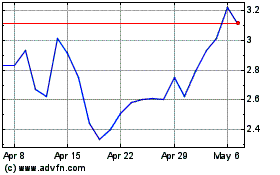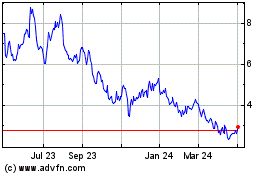Adaptive Biotechnologies Corporation (Nasdaq: ADPT), a commercial
stage biotechnology company that aims to translate the genetics of
the adaptive immune system into clinical products to diagnose and
treat disease, today announced new data demonstrating the strengths
of Adaptive’s next-generation sequencing (NGS)-based clonoSEQ®
Assay in measuring minimal residual disease (MRD) in blood cancer
patients. The data are being presented at the 64th Annual Meeting
of the American Society of Hematology (ASH) taking place December
10-13, 2022.
MRD refers to the small number of cancer cells that can remain
in a patient’s body after treatment, which often cause no signs or
symptoms but eventually can lead to recurrence of the disease.
These residual cells can be present at very low levels and can only
be identified by highly sensitive tests. clonoSEQ, which is the
only FDA-cleared test for MRD assessment in lymphoid malignancies,
is highly accurate, sensitive, and standardized compared to other
technologies used for disease burden assessment.
“Data at this year’s ASH meeting continue to show the benefits
of serial MRD measurement for blood cancer patients both in routine
patient care and in clinical trials,” said Nitin Sood, chief
commercial officer, MRD, Adaptive Biotechnologies. "Multiple
studies presented at ASH reinforce that clonoSEQ MRD results can
play an important role in some of the most challenging decisions
clinicians must make on a daily basis, such as whether and when to
stop treatment."
Real-world evidence generated from the University of Alabama,
Birmingham, demonstrated the feasibility of MRD testing with
clonoSEQ to guide treatment decisions. The data were presented in a
poster presentation titled, Induction Quadruplet Therapy
and Minimal/Measurable Residual Disease (MRD)-Informed Treatment
Adaptation in Newly Diagnosed Multiple Myeloma (NDMM): Results from
an Academic-Community Pathway (Abstract
3593). The study
adopted a modified treatment approach from the MASTER trial and
evaluated 69 patients who were treated with the combination of
daratumumab, Velcade, carfilzomib, lenalidomide and dexamethasone
(mDara-VRd). MRD was assessed utilizing clonoSEQ at multiple
timepoints. Of 42 patients with trackable MRD and >12 months
post initiation of therapy,16 patients (38%) achieved two
consecutive MRD-negative results <10-5, which facilitated
subsequent treatment discontinuation and entry into the MRD
surveillance (MRD-SURE) phase of the study.
“We are encouraged by these real-world results, which suggest
that monitoring MRD closely at multiple time points can impact
informed decision-making regarding discontinuation of maintenance
therapy for patients with MM,” said Gayathri Ravi, MD, Principal
Investigator from O’Neal Comprehensive Cancer Center at the
University of Alabama at Birmingham. “Evidence supporting MRD-based
treatment decisions has been mounting in clinical trials and
academic centers, so we are pleased this study shows the
feasibility of this prognostic approach in the community clinical
setting in coordination with an academic center. A long duration of
maintenance therapy can have a negative impact on patients –
studies have shown most patients are unable or unwilling to stay on
maintenance therapy indefinitely. An MRD-informed approach to
treatment discontinuation that can relieve them of that burden is
critical for real-world patient management.”
Similar to the study above, data generated from the prospective
MRD2STOP study indicates that MRD testing with clonoSEQ may help
identify patients with MM who can discontinue maintenance therapy.
The data were presented in an oral presentation titled,
Prospective Trial Using Multimodal Measurable Residual
Disease Negativity to Guide Discontinuation of Maintenance Therapy
in Multiple Myeloma (MRD2STOP) (Abstract
870). The study evaluated
discontinuation of maintenance in 38 MM patients with a median
duration of consolidation or maintenance therapy of 42 months prior
to discontinuation. To date, MRD resurgence at the 10-6 threshold
was only identified in 5 (13%) patients, which included only two
patients with disease progression. The rate of sustained MRD
negativity (10-6) at 12 months was 84%. This implies that
discontinuation of maintenance therapy based on MRD assessment was
accompanied by high rates of sustained MRD negativity and lack of
disease progression. In an exploratory goal for the study, we show
that performing clonoSEQ on CD138+-selection of bone marrow
aspirate samples not only appear to improve the depth of MRD
testing to 10-7 but also predict which patients may experience
disease resurgence if they undergo discontinuation of all therapy.
Longer follow-up studies are in progress.
“This study reinforces that MRD status is an important tool to
help predict disease progression in MM, especially when considering
de-escalation of therapy,” said Ben Derman, MD, Assistant Professor
of Medicine at the University of Chicago. “Precise measurement of
MRD negativity is proving to be key in knowing whether a treatment
is effectively producing a deep and durable response. We look
forward to continuing this study and implementing MRD-informed
decisions to determine duration of maintenance as
standard-of-care.”
Additional Key clonoSEQ Data Presented at the
Meeting:
Outcomes of MRD-Adapted Treatment Modulation in Patients
with Newly Diagnosed Multiple Myeloma Receiving Daratumumab,
Carfilzomib, Lenalidomide and Dexamethasone (Dara-KRd) and
Autologous Transplantation: Extended Follow up of the Master Trial
(Abstract 3237)
- This study investigated the
possibility of discontinuing maintenance therapy by measuring MRD
negativity with the clonoSEQ Assay. Patients were treated with the
combination of daratumumab, carfilzomib, lenalidomide and
dexamethasone (Dara-KRd).
- The study concludes that for the
majority of patients in the study without ultra-high-risk disease,
MRD response-adapted treatment provided the opportunity to
discontinue maintenance therapy without compromising disease
control. The median follow-up in the study post therapy
discontinuation was 24.8 months.
Immunoglobulin High Throughput Sequencing (Ig-HTS)
Minimal Residual Disease (MRD) Analysis Is an Effective
Surveillance Tool in Patients with Mantle Cell Lymphoma
(Abstract 4806)
- This study conducted retrospective
data collection and an analysis of outcomes in patients who
underwent first-line treatment for mantle cell lymphoma (MCL) and
were then monitored post-treatment using the clonoSEQ Assay.
- The data suggest that the clonoSEQ
Assay is an effective surveillance tool for MCL patients following
first-line therapy. Based on the data, clonoSEQ was predictive of
relapse prior to imaging in all but one patient. In addition, the
assay allowed for minimization of surveillance imaging, and early
detection of MRD allowed for pre-emptive rituximab therapy in
select patients.
Venetoclax, Ibrutinib, Prednisone, Obinutuzumab, and
Lenalidomide (ViPOR) in Relapsed and Refractory Follicular
Lymphoma: Analysis of Safety, Efficacy, and Minimal Residual
Disease (Abstract
952)
- This analysis focused on data from
patients with relapsed and refractory (r/r) follicular lymphoma
(FL) treated with the ViPOR regimen. Response was assessed using
imaging and MRD assessment from ctDNA with clonoSEQ.
- The results showed 88% of patients
in complete remission were MRD-negative at the end of their
treatment, and their MRD status was predictive of progression-free
survival.
About the clonoSEQ AssayThe clonoSEQ Assay is
the first and only FDA-cleared in vitro diagnostic (IVD) test
service to detect minimal residual disease (MRD) in bone marrow
from patients with multiple myeloma (MM) or B-cell acute
lymphoblastic leukemia (B-ALL) and blood or bone marrow from
patients with chronic lymphocytic leukemia (CLL). clonoSEQ testing
for diffuse large B-cell lymphoma (DLBCL) patients is currently
available for clinical use as a laboratory-developed test (LDT)
performed at Adaptive's CLIA-certified lab in Seattle, WA. clonoSEQ
ctDNA-based MRD testing in DLBCL has also been approved by New York
State's Clinical Laboratory Evaluation Program (CLEP). Medicare
covers clonoSEQ in these four indications and is aligned with
clinical practice guidelines which support assessing MRD at
multiple time points throughout therapy to monitor treatment
response and help predict patient outcomes.
The clonoSEQ Assay leverages Adaptive Biotechnologies’
proprietary immune medicine platform to identify and quantify
specific DNA sequences found in malignant cells, allowing
clinicians to assess and monitor MRD during and after treatment.
The assay provides standardized, accurate, and sensitive
measurement of MRD that allows physicians to predict patient
outcomes, assess response to therapy over time, monitor patients
during remission, and predict potential relapse. Clinical practice
guidelines in hematological malignancies recognize that MRD status
is a reliable indicator of clinical outcomes and response to
therapy, and clinical outcomes have been shown to be strongly
associated with MRD levels measured by the clonoSEQ Assay in
patients diagnosed with CLL, MM, ALL and DLBCL.
For important information about the FDA-cleared uses of
clonoSEQ, including the full intended use, limitations, and
detailed performance characteristics, please visit
www.clonoSEQ.com/technical-summary.
About Adaptive BiotechnologiesAdaptive
Biotechnologies (“we” or “our”) is a commercial-stage biotechnology
company focused on harnessing the inherent biology of the adaptive
immune system to transform the diagnosis and treatment of disease.
We believe the adaptive immune system is nature’s most finely tuned
diagnostic and therapeutic for most diseases, but the inability to
decode it has prevented the medical community from fully leveraging
its capabilities. Our proprietary immune medicine platform reveals
and translates the massive genetics of the adaptive immune system
with scale, precision and speed. We apply our platform to partner
with biopharmaceutical companies, inform drug development, and
develop clinical diagnostics across our two business areas: Minimal
Residual Disease (MRD) and Immune Medicine. Our commercial products
and clinical pipeline enable the diagnosis, monitoring, and
treatment of diseases such as cancer, autoimmune disorders, and
infectious diseases. Our goal is to develop and commercialize
immune-driven clinical products tailored to each individual
patient.Forward Looking Statements This press
release contains forward-looking statements that are based on
management’s beliefs and assumptions and on information currently
available to management. All statements contained in this release
other than statements of historical fact are forward-looking
statements, including statements regarding our ability to develop,
commercialize and achieve market acceptance of our current and
planned products and services, our research and development
efforts, and other matters regarding our business strategies, use
of capital, results of operations and financial position, and plans
and objectives for future operations.
In some cases, you can identify forward-looking statements by
the words “may,” “will,” “could,” “would,” “should,” “expect,”
“intend,” “plan,” “anticipate,” “believe,” “estimate,” “predict,”
“project,” “potential,” “continue,” “ongoing” or the negative of
these terms or other comparable terminology, although not all
forward-looking statements contain these words. These statements
involve risks, uncertainties and other factors that may cause
actual results, levels of activity, performance or achievements to
be materially different from the information expressed or implied
by these forward-looking statements. These risks, uncertainties and
other factors are described under "Risk Factors," "Management's
Discussion and Analysis of Financial Condition and Results of
Operations" and elsewhere in the documents we file with
the Securities and Exchange Commission from time to time.
We caution you that forward-looking statements are based on a
combination of facts and factors currently known by us and our
projections of the future, about which we cannot be certain. As a
result, the forward-looking statements may not prove to be
accurate. The forward-looking statements in this press release
represent our views as of the date hereof. We undertake no
obligation to update any forward-looking statements for any reason,
except as required by law.
ADAPTIVE MEDIAMary Pat
Lancelotta206-600-6702media@adaptivebiotech.com
ADAPTIVE INVESTORSKarina Calzadilla, Vice
President, Investor
Relations201-396-1687investors@adaptivebiotech.com
Adaptive Biotechnologies (NASDAQ:ADPT)
Historical Stock Chart
From Mar 2024 to Apr 2024

Adaptive Biotechnologies (NASDAQ:ADPT)
Historical Stock Chart
From Apr 2023 to Apr 2024
